Mønter fra middelalderlige landbebyggelser – Et overset kildemateriale til belysning af bønders møntbrug
DOI:
https://doi.org/10.7146/kuml.v65i65.24832Nøgleord:
mønter, middelalder, landbebyggelser, bønders møntbrugResumé
Coins from Medieval rural settlements
An overlooked record of peasant coin use
It is much discussed among historians, numismatists and archaeologists whether peasants made use of coins in the Middle Ages, or whether they simply lived off their own products and turned to barter on the rare occasions when they had to acquire something. Written sources show that peasants sometimes paid taxes and rents in coin, sometimes in kind. Finds of coins (hoards, finds from church floors and, not least, metal-detector finds) clearly demonstrate that coins were available in large numbers in rural areas, at least from the 13th century onwards. But can we securely link them to peasants? They may have been handled by nobles or the clergy.
A hitherto neglected category of evidence may help us in this respect, i.e. coins found in archaeological layers during excavations of villages or farms. These finds are rarer than one might think, but this is due more to modern bias than Medieval reality. Because abandoned villages have often subsequently been cultivated, leading to destruction of the archaeological stratigraphy by the plough and leading to artefacts formerly in context now being in the top soil.
It is not the aim of this paper to undertake an all-embracing analysis. Drawing on a limited number of rural sites on Zealand, in particular Tårnby, Store Valby and Hejninge, with well preserved archaeological stratigraphies, its ambition is to demonstrate the potential of this type of evidence.
The first part deals with the occurrence of coins. It turns out that coins are present in secure peasant contexts at many sites, on both ordinary and wealthy farms. In villages, they are in several instances occurring at all of the excavated farms. There are, however, a number of well-excavated village sites with no coin finds at all. This may be due to a poor state of preservation and inadequate excavation techniques, but in some instances at least it may reflect Medieval reality. The scope of the present paper is too limited for firm conclusions to be drawn, but different social and economic conditions may have resulted in more or less intensive coin use. Maybe the prosperous crop-growing peasants of the Køge-Roskilde area only sold their harvest once a year and then paid their rents, but did not use coins on an everyday basis. While the poorer peasants in northern Zealand had to engage in some timber trading, honey production etc., which led to them using coins more frequently. This is, however, just a hypothesis that needs to be tested by a larger scale study.
The second part looks in more detail at the archaeological context. Each coin is assessed for whether it is contemporary with its context or not; the nature of its context is established (occupation layer, construction, destruction); the position of the find-spot within the farm is determined; it is then discussed whether the find-spot is where the coin was originally lost or deposited, or whether the coin has been moved during earthworks or other human or natural activities.
It turns out that a large proportion of the coins derives from floors of the farm houses: in living rooms, kitchens and pantries. These are predominantly contemporary with the contexts. There are also coins from stables and courtyards, as well as from rubbish pits. Small purses containing a few coins are also recorded. The emerging picture is of intensive day-to-day coin use resulting in accidental coin losses within the farm, i.e. the private and production spheres of the peasants. One has to remember that coin finds are merely the residue, representing the coins that were not recovered by the people who lost them, and that most coins were not lost. Consequently, the level of monetary activity must have been considerable.
Relatively few coins derive from secondary or disturbed contexts, most of which are linked to construction works. This is in sharp contrast to what we usually see at urban sites, where more intensive construction activity through the centuries has disturbed the archaeological contexts to a major degree. A few coins may be deliberate deposits, in a pit or beneath an entrance, intended to bring good fortune to the house, but none occur in an unambiguous context which would allow us to be certain of this interpretation.
This paper shows the potential for using coins recovered from archaeological contexts at rural sites to demonstrate that peasants handled coins during the Middle Ages, at least from c. 1200 onwards. The scope of this survey is too limited for general conclusions to be drawn, and the sites without coins suggest that there may be chronological, geographical or social variations that we will only be able to understand if larger-scale investigations are embarked upon.
Jens Christian Moesgaard
Nationalmuseet
Fotos: Tine Bonde Christensen
Nationalmuseet
Downloads
Publiceret
Citation/Eksport
Nummer
Sektion
Licens
Fra og med årgang 2022 er artikler udgivet i Kuml med en licens fra Creative Commons (CC BY-NC-SA 4.0).
Alle tidligere årgange af tidsskriftet er ikke udgivet med en licens fra Creative Commons.


